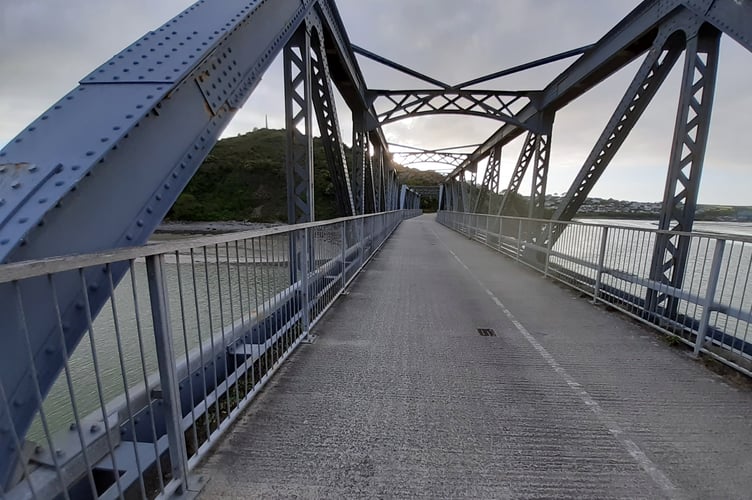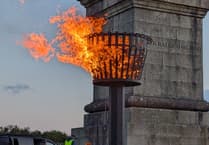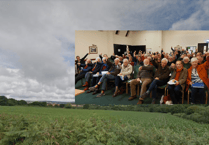Ghosts of the past are never far away when visiting the popular Camel Trail, a multi-use trail linking Bodmin with Wadebridge, Padstow and via a deviation – Wenfordbridge on Bodmin Moor.
While evidence of its former life as Cornwall’s first passenger railway line are significantly fewer and scarce then they would have been in the time where steam ruled the route, some clues of the past life of the trail still remain extant.
Some are more obvious than others, not least the platforms between Bodmin and Wadebridge which now adorn large replica Southern-railway style signs reminding people of the names of the stations that saw service between 1906 and 1967.
Then there’s the section at Boscarne, where the Camel Trail adjuncts with the living museum of the Bodmin and Wenford Railway, a preservation society and much-loved attraction which reminds locals and visitors alike of the era which the railway once inhabited.
Some relics are less obvious, such as the odd left behind mile post, signal tower where once a semaphore signal would have been present or the odd bit of rail laying abandoned in the road, a reminder of the level crossings no longer required or indeed, the odd fence post looking decidedly ancient.
Some of the relics left behind by the railway, however, are decidedly larger; such as structures and buildings.
This is the architecture the railways left behind.
Little Petherick Bridge
Becoming surplus to requirements as a railway bridge upon the closure of the Padstow to Wadebridge section of the North Cornwall Railway on January 30, 1967, it is perhaps a miracle that the Little Petherick Bridge, just outside of Padstow didn’t fall foul of the blow torches and demolition teams that saw the demise of many other railway structures at a similar time.
Instead of wondering what the Camel Trail without it might have looked like, its dormancy between the end of the railways and the opening of the trail meant that today we can enjoy the spectacular views of the Camel Estuary on foot or by bicycle in a similar manner to how tourists and locals alike would have enjoyed it by rail a few decades before.
Rewind back to 1896 and the London and South Western Railway (LSWR) are in a quandry – one that had things been slightly different, meant that there may never have been a Little Petherick Bridge.
The North Cornwall Railway was mostly built by this point, with Bodmin and Wadebridge connected with Launceston and beyond with a deviation from the line which crossed a long-demolished bridge at Sladesbridge at a location approximately where Trelawney Garden Centre now sits.
However, the LSWR were undecided on what to do next and at this point, were seriously considering building an extension of the line to Truro via their short goods only branch to Ruthernbridge. By the time they’d decided against it and opted instead to build the line from Padstow to Wadebridge, the original act of parliament enabling it had expired, meaning they had to seek fresh permission to proceed.
Come December 1896, and all was in place to build Little Petherick Bridge, which would enable the railway to cross the Camel Estuary. W.R Galbraith, the LSWR’s main engineer and often overlooked in favour of Brunel in the debate of greatest railway engineers of the Victorian period, was behind the design of the bridge, with Galbraith and Church serving as the engineers for the route.
Much like his earlier pioneering design at Meldon Viaduct, which eschewed traditional stone masonry and extensive use of wood in favour of a predominantly metal construction, Little Petherick was to be an iron wrought bridge, built using Pratt trusses combined with nine cross girders and three wind braces, providing a deck width of 16 feet, three inches.
With the bridge being built across an estuary, construction certainly wasn’t straightforward and so it proved. The iron work was brought to Wadebridge by the contractors, Derby based Messrs Eastwood, Swingler and Co on barges down the river, with each truss weighing 350 tons.
Each 200-ton cylinder which would comprise the central support of the bridge was loaded with a fifty ton weight causing it to sink through the river silt and where bedrock was found, the mud had to be excavated using grabs, sometimes leading to 48 hours being taken to excavate a single yard in depth.
After the closure of the line in 1967, Little Petherick remained with seemingly little future other than being a railway relic no one had even got around to demolishing. However, the creation of the Camel Trail meant that it would enjoy a new life and after an extensive restoration, it would again transport people, albeit on foot or bicycle.
Initially, connection via the bridge was across a narrow wooden walkway in the centre of the bridge, but a later restoration work as part of a full refurbishment restored the bridge to its full splendour with a full-width deck installed.

Wadebridge Railway Station
Two railway stations remain on the Camel Trail – at Padstow and Wadebridge. The station which once served as the terminus of the line, at Bodmin North, is long demolished with the site of the station building used as a car park, the sidings now occupied by supermarkets and the old trackbed going towards the supermarket now serving as an access road and pothole farm.
At Padstow, the old railway station still remains, and these days sees service as the headquarters for Padstow Town Council.
However, it is at Wadebridge where a new life was found for their former railway station that still served the public which once would have used it in its former days.
Named after the famed poet laureate and railway campaigner, John Betjeman who came to call North Cornwall his home in later years, the John Betjeman Centre occupying the old station building now serves as a hub for the elderly as well as being a vital community amenity.
You would barely recognise the area it occupies these days, for the entire site save for the old station building and the adjacent goods shed has been redeveloped into houses, a car park and a supermarket; the railway ran through the centre of Wadebridge with a narrow road adjoining it and crossing using a level crossing.
Indeed, the station building wasn’t the original station. The original station had been built on a triangle of land bounded by the River Camel, known as the Polmorla Brook and what is known in the town today as The Platt. It was a single platform and engine shed on the town side of the line, continuing across Molesworth Street and serving the quays immediately downstream of Wadebridge bridge.
With the arrival of the North Cornwall Railway imminent, a bigger station would be required to both host that line and the Bodmin and Wadebridge railway which had served the town since 1834. A new station was built between 1888 and 1895 at the location it stands in today, slightly nearer Bodmin and comprised the one-storey station with a ticket office and waiting rooms.
The arrival of the line from Padstow meant that the Wadebridge station had to expand and in 1899, an island platform adding two additional platforms and linked by a wooden lattice footbridge was provided, with the new platform including a waiting room and a canopy, with the new platforms opening on March 27, 1899.
The footbridge was replaced by a pre-cast concrete one during the 1920s. While the station closed to passengers in 1967, it remained open until 1978 as an access point for freight. It was in the latter years, as a mostly abandoned station that the man who the station would later be named after, Sir John Betjeman was captured on film looking forlornly at the remains of Wadebridge Station in the TV retelling of his ‘Summoned by Bells’ verse autobiography, in a part where he describes his memories of coming to Cornwall on holiday. Name checking Wadebridge, he said: “On Wadebridge Platform what a breath of sea scented the Camel valley! Cornish air, Soft Cornish rain, And silence after steam...”
The vast majority of the station was demolished and redeveloped after its closure in 1978, although the section from Padstow to Wadebridge closed eleven years previously in 1967.
The plate layer’s hut
Between the start of the Camel Trail, in Bodmin and its first station at Dunmere Halt, lies a line-side curiosity. It is a concrete building with a bench in the middle and no sides.
It might be easy to think it was always designated as a resting place for weary walkers, but it is in fact a relic of something that played an important part in railway maintenance of the past, for it is a plate layer’s hut.
Unlike today where mobile teams undertake railway maintenance, in the early days, the ‘plate layer’ (a name derived from the early form of railways, known as plateways) was an individual who had responsibility for the maintenance and upkeep of a stretch of railway about one to two miles long. The shelter would serve as their working base and shelter, from where they would patrol the track under their responsibility.
Inside this plate layer’s hut would often be a table, chairs, heating stove and sometimes a fire, with the hut having a chimney attached to it.
This particular example was likely made during or shortly after the 1920s, with the design and use of concrete suggesting it was of a Southern Railway design with the concrete coming from their works at Exmouth Junction.
Many of these types of huts lay in varying states of condition today; and this particular example has been converted into a resting shelter for users of the Camel Trail.
The remains of a similar concrete building adjoins a private property between Dunmere and Boscarne Junction at the point where the line to Wenfordbridge would depart from the line to Bodmin North and is in a state of dilapidation.





Comments
This article has no comments yet. Be the first to leave a comment.